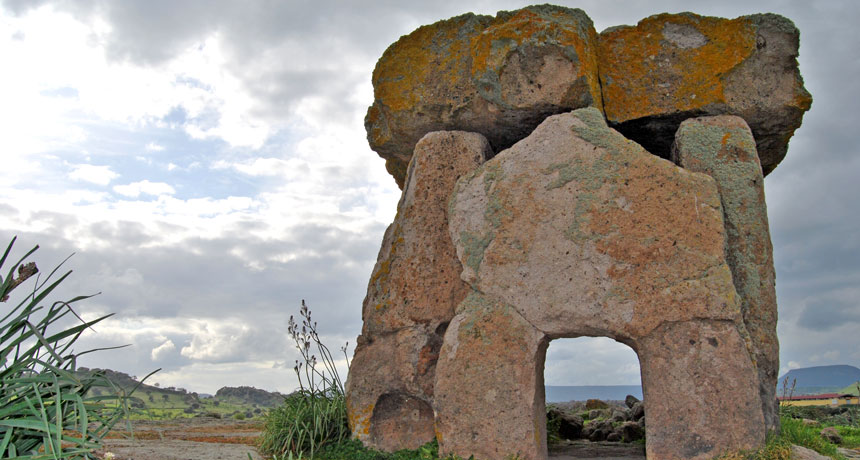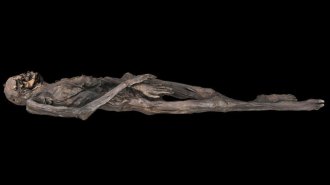The spread of Europe’s giant stone monuments may trace back to one region
Ancient sea travelers carried the knowledge of how to build megaliths from France

ROCK ON Huge stone structures found throughout Europe spread out in three waves starting as early as 6,800 years ago, a new study finds. This stone grave on Sardinia in Italy dates to around 5,000 years ago.
B. Schulz Paulsson
From simple rock arches to Stonehenge, tens of thousands of imposing stone structures dot Europe’s landscapes. The origins of these megaliths have long been controversial. A new study suggests that large rock constructions first appeared in France and spread across Europe in three waves.
The earliest megaliths were built in what’s now northwestern France as early as around 6,800 years ago, says archaeologist Bettina Schulz Paulsson of the University of Gothenburg in Sweden. Knowledge of these stone constructions then spread by sea to societies along Europe’s Atlantic and Mediterranean coasts, she contends in a study posted online the week of February 11 in the Proceedings of the National Academy of Sciences.
“European megaliths were products of mobile, long-distance sea travelers,” Schulz Paulsson says.
Around 35,000 megalithic graves, standing stones, stone circles and stone buildings or temples still exist, many located near coastlines. Radiocarbon dating has suggested that these structures were built between roughly 6,500 and 4,500 years ago.
Scholars a century ago thought that megaliths originated in the Near East or the Mediterranean area and spread elsewhere via sea trading or land migrations by believers in a megalithic religion. But as absolute dates for archaeological sites began to emerge in the 1970s, several researchers argued that megaliths emerged independently among a handful of European farming communities.
Schulz Paulsson used statistical tests to identify a model that best explained the origin and spread of 154 dated megalith sites. Her calculations relied on 2,410 radiocarbon dates. Some sites included presumed megalith precursors, such as small graves dug into the ground or large earthen monuments, that aided in reconstructing where and when megaliths first spread.
The earliest megalithic graves consisted of two or more standing stones topped by a third stone or by a mound of earth. That construction style spread from northwest France down the Atlantic coast and into the Mediterranean between around 6,800 and 6,000 years ago, Schulz Paulsson says. Large earthen graves without stones were built shortly before the rise of megaliths and appear only at sites in northwest France, pegging that region as the likely birthplace of megalithic graves, she contends.
A second type of megalith gained widespread popularity between about 6,000 and 5,500 years ago, Schulz Paulsson finds. Thousands of “passage graves,” consisting of a narrow stone passage connected to one or more burial chambers covered in earth or stone, were built at sites along coasts of Portugal, Spain, Ireland, England, Scotland and France. Sea voyagers plying established trade routes must have linked those areas and led to a major change in burial practices, signified by the proliferation of passage graves, Schulz Paulsson says.
Finally, after around 5,500 years ago, passage graves reached Scandinavia and north-central Europe and other megalithic structures spread to additional coastal sites. Massive boulders were raised at Stonehenge in southwestern England around 4,400 years ago (SN Online: 9/6/12).
General trends in the spread of megaliths reported by Schulz Paulsson appear likely, says archaeologist Alasdair Whittle of Cardiff University in Wales. It’s not surprising that sea travel was involved, since megaliths are found in England and Ireland as well as across continental Europe, he says. More radiocarbon dates are needed to specify, for example, when people in northwestern France built huge earthen mounds that later became spots for megalith construction.
Editor’s note: This story was updated February 14, 2019, to correct when passage graves appeared in Scandinavia. They appeared in that region only during the third wave of the spread of megaliths, not earlier.







